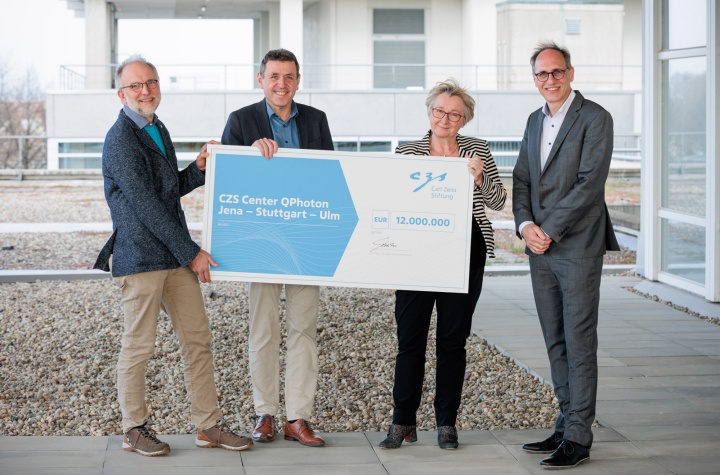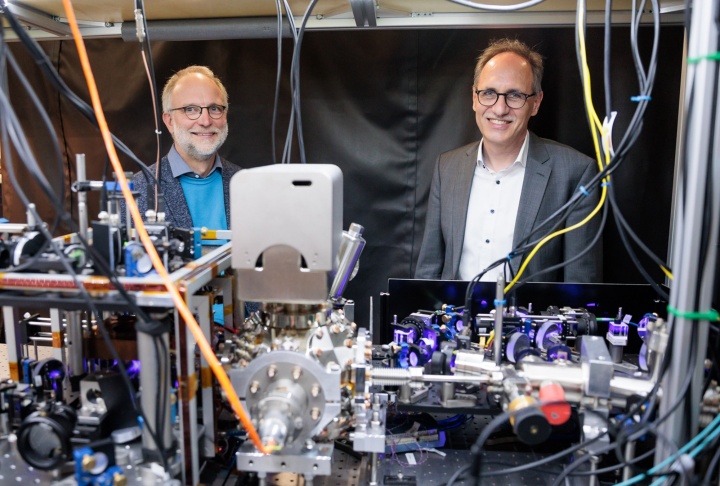Opened on March 29, 2022, at the universities of Stuttgart, Ulm and Jena, the facility is the first national center for quantum photonics. The center, which has received 12 million euros of funding from the Carl Zeiss Foundation, will provide a cross-disciplinary and cross-location platform for research and exchange for around 50 scientists. At the University of Stuttgart, research focuses on quantum technologies for quantum imaging, and initial applications such as quantum microscopy in life sciences will also be developed here. At the opening, Minister Theresia Bauer in Stuttgart and Minister Wolfgang Tiefensee in Jena presented a check for the total funding amount to the center directors from all three locations.
"'New materials and quantum technology' is one of three key research areas that the University of Stuttgart is focusing on. The Carl Zeiss Foundation Center QPhoton is thus making an important contribution to raising our profile and strategically strengthening our research," emphasizes Prof. Dr. Manfred Bischoff, Vice Rector for Research and Early Career Researchers at the University of Stuttgart.
Theresia Bauer, Baden-Württemberg's Minister of Science and Chairwoman of the Carl Zeiss Foundation's Board of Trustees, says: "Quantum technologies have the potential to decisively advance fields of innovation. To be at the forefront of international competition, we need to create cross-regional structures to share our knowledge."
Lasers, magnetic resonance imaging and semiconductors are technologies from the field of quantum physics that are already shaping our lives today. The potential of quantum technologies in the fields of communication, computing, sensor technology and imaging dominates technological debates about the future. To exploit this potential, nationwide platforms are needed that bring together different areas of expertise.
Photonics as a key technology
Photonics is a key technology in the field of quantum science: Photons serve as sensor elements, data transmitters and quantum systems. Establishing a network of quantum technologies and photonics forms the foundation of the Carl Zeiss Foundation (CZS) Center QPhoton at the Jena, Stuttgart and Ulm sites. The aim is to develop a new generation of imaging and sensor technologies based on quantum science. These should enable higher sensitivities and faster data processing.
Linking the three locations will further advance quantum photonics not just in terms of basic research, but also its application. The respective strengths in the fields of quantum technologies with atoms, solids, superconducting materials and photons complement each other and allow for a targeted furtherance of early career researchers.
Research in Stuttgart, Ulm and Jena
At the CZS Center QPhoton, this goal is being advanced across three areas of innovation: Quantum technologies for quantum imaging, sensor technologies for quantum systems control, and quantum-based information processing.
- In the area of quantum technologies for quantum imaging, one focus will be on developing initial applications such as quantum microscopy in life sciences. For example, precisely determining the position and nature of molecules enables the exploration of new applications in cancer therapy.
- In the area of sensor technologies for the control of quantum systems, the scientists focus on researching and developing highly sensitive sensors.
- The area of quantum-based Information Processing focuses on the development of data and signal processing methods, as well as specific photonics hardware for use in quantum computing.
About the Carl Zeiss Foundation
The aim of the Carl Zeiss Foundation is to facilitate scientific breakthroughs. As a partner of excellent science, it supports both basic research and application-oriented research and teaching in the STEM subjects (science, technology, engineering, and mathematics). Founded by the physicist and mathematician Ernst Abbe in 1889, the Carl Zeiss foundation is one of the oldest and largest private science-focused foundations in Germany. The foundation is the sole owner of Carl Zeiss AG and SCHOTT AG. Its projects are financed by distributing the dividends of the foundation's two companies.




